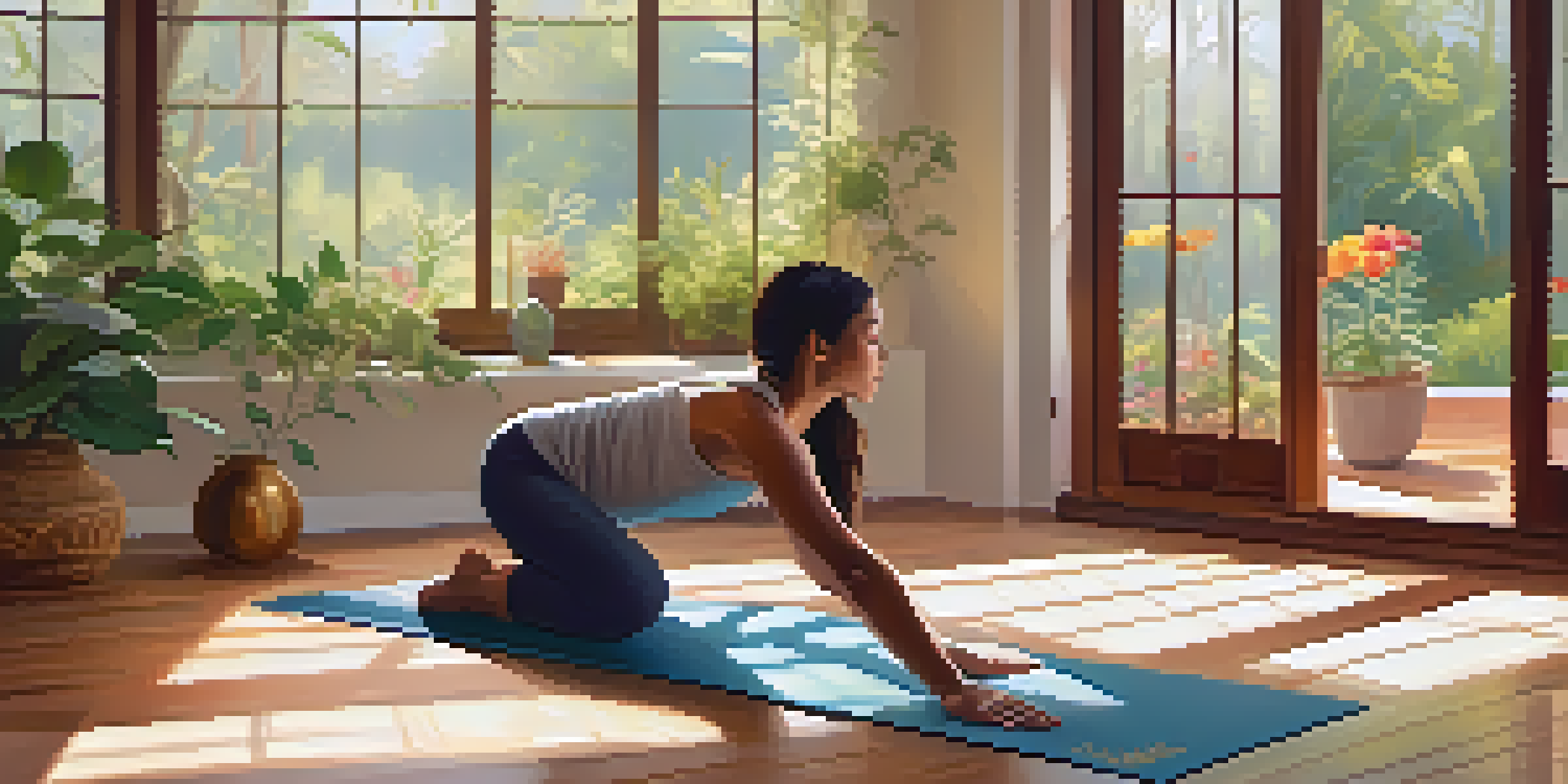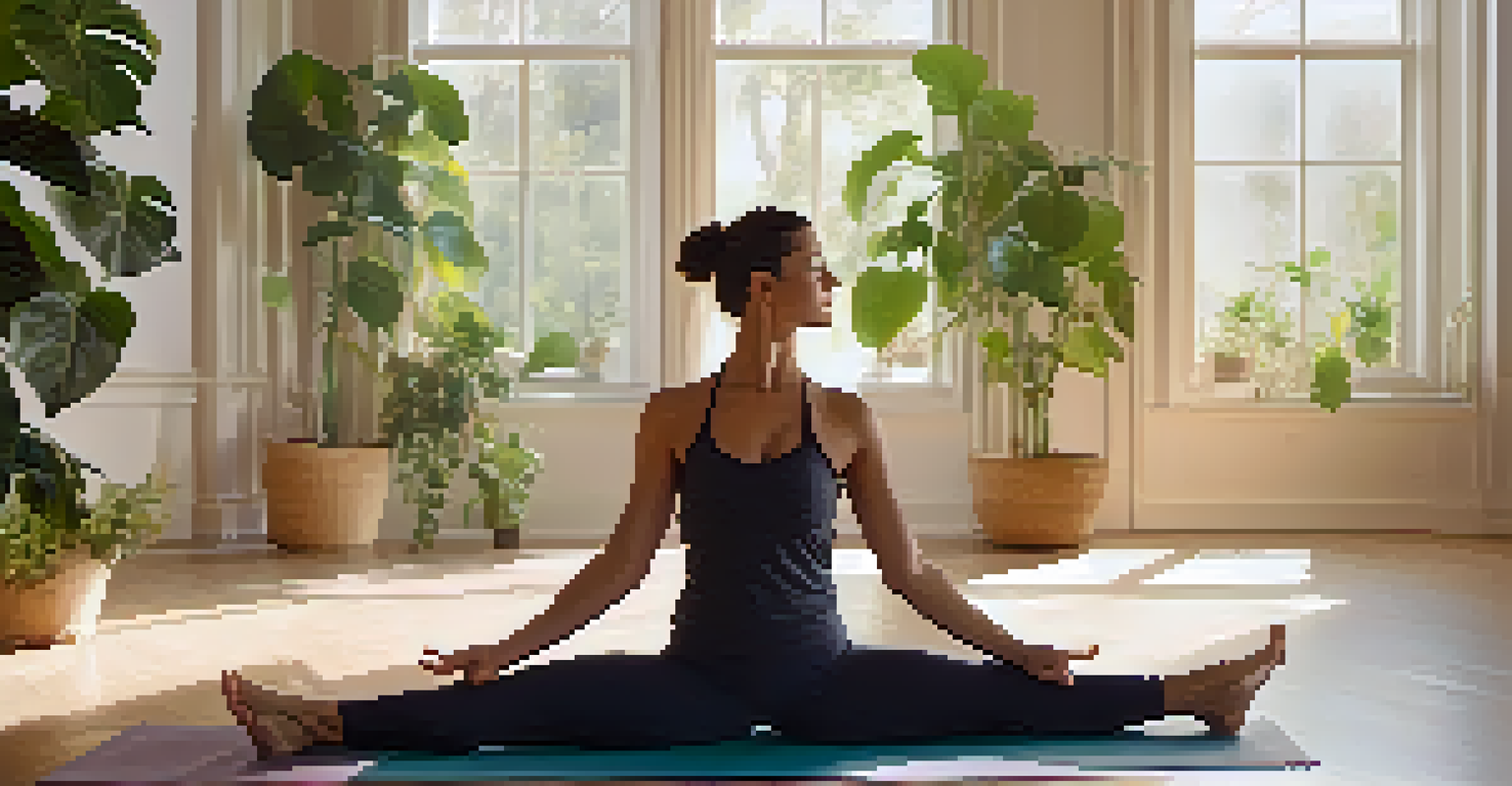Yoga Poses That Ignite Creativity: A Practical Guide

Understanding the Connection Between Yoga and Creativity
Yoga is more than just a physical practice; it's a holistic approach that caters to the mind, body, and spirit. When you engage in yoga, you’re not only stretching and strengthening your muscles but also opening pathways to creative thinking. This connection arises from the calming effects of yoga, which helps reduce stress and clears mental clutter.
Yoga is the journey of the self, through the self, to the self.
The state of relaxation achieved through yoga can lead to heightened awareness and a more open mindset. Think of it like clearing a foggy window; once the haze is gone, you can see more clearly and creatively. Research has shown that practices like mindfulness in yoga can stimulate divergent thinking, a key component of creativity.
By incorporating yoga into your routine, you may find that ideas flow more freely, and problem-solving becomes less daunting. Just as a painter needs a clear canvas to create their masterpiece, you need a clear mind to explore your creative potential.
Pose 1: Child's Pose for Grounding Your Mind
Child's Pose, or Balasana, is a restorative position that invites relaxation and introspection. When you settle into this pose, your forehead rests on the mat, allowing your mind to quiet down and focus inward. This grounding sensation can help you connect with your inner thoughts and ideas, making it a perfect starting point for creativity.

As you hold Child's Pose, focus on your breath, letting each inhalation and exhalation draw you deeper into a state of calm. This practice not only soothes the nervous system but also opens space for new thoughts to emerge. It’s like hitting the reset button on your brain, allowing fresh ideas to bubble to the surface.
Yoga Enhances Creative Thinking
Engaging in yoga not only calms the mind but also opens pathways to creative thinking by reducing stress and mental clutter.
Many artists and writers use this pose to combat creative blocks. The stillness of Child's Pose helps create a mental environment where inspiration can thrive, making it an essential tool in your creative yoga toolkit.
Pose 2: Downward Dog to Boost Energy and Focus
Downward Dog, or Adho Mukha Svanasana, is more than just a popular pose; it's an energizing inversion that promotes blood flow to the brain. While in this pose, your heart is elevated above your head, which can stimulate mental clarity and focus. This burst of energy can serve as a catalyst for creative thoughts to emerge.
Creativity takes courage.
As you stretch and elongate your spine, visualize releasing any stagnant energy that may be blocking your creativity. The act of folding forward allows you to shift your perspective, quite literally and figuratively. It’s similar to changing the angle of a painting to see it in a new light.
Practicing Downward Dog regularly can lead to improved concentration and a sharper mind, both of which are essential for creative pursuits. By incorporating this pose into your routine, you're setting the stage for a creative flow that can lead to innovative ideas.
Pose 3: Warrior II for Confidence and Courage
Warrior II, or Virabhadrasana II, is a powerful pose that embodies strength and determination. As you stand tall with your arms extended, you cultivate a sense of confidence that can be incredibly beneficial for creative expression. This pose encourages you to embrace your ideas boldly and without hesitation.
The strong stance of Warrior II also helps you ground your energy, balancing the mind and body. Just as a warrior prepares for battle, you can prepare yourself to face creative challenges head-on. This mental fortitude can be a game-changer when it comes to overcoming self-doubt in your creative process.
Poses Foster Emotional Release
Specific yoga poses, like Pigeon and Bridge, help release emotional tension and foster openness, allowing creativity to flow more freely.
By practicing Warrior II, you're not just building physical strength; you're also nurturing a courageous mindset that empowers your creativity. This blend of physical and mental strength can help you tackle projects with renewed vigor and passion.
Pose 4: Seated Forward Bend for Reflection and Insight
Seated Forward Bend, or Paschimottanasana, invites introspection and reflection. As you fold forward over your legs, you create a gentle stretch along your back and hamstrings, which can help release tension. This act of bending forward is symbolic of looking within, allowing you to tap into your inner thoughts and feelings.
While in this pose, take a moment to breathe deeply and ponder your creative goals. The forward motion can represent a willingness to explore new ideas and perspectives. Think of it as a gentle nudge to let go of any preconceived notions that may be stifling your creativity.
Incorporating Seated Forward Bend into your practice can enhance your ability to reflect on your creative journey. The clarity gained from this pose can lead to surprising insights that may shape your artistic endeavors.
Pose 5: Bridge Pose for Openness and Expression
Bridge Pose, or Setu Bandhasana, opens the heart and chest, promoting emotional release and expression. This pose encourages a sense of openness that can be incredibly beneficial for tapping into your creative self. As you lift your hips and chest, you create space for your heart and mind to connect more freely.
The uplifting nature of Bridge Pose can help dispel feelings of doubt or fear, allowing your creativity to flow more freely. It’s like opening a window to let fresh air into a stuffy room; once the space is clear, inspiration can rush in. Embracing this openness can lead to new ways of seeing and experiencing the world around you.
Reflection Boosts Creative Insights
Incorporating poses such as Seated Forward Bend and Corpse Pose encourages introspection, leading to surprising insights that enhance creative expression.
Practicing Bridge Pose regularly can foster a greater sense of emotional awareness, helping you express your creativity authentically. By allowing your heart to shine, you can create work that resonates deeply with others.
Pose 6: Pigeon Pose for Releasing Creative Blocks
Pigeon Pose, or Eka Pada Rajakapotasana, is known for its ability to release tension in the hips, where many people store emotional stress. By opening up this area, you can free up stagnant energy that may be blocking your creative flow. It’s like unblocking a dam; once the water flows freely, creativity has the space to flourish.
While in Pigeon Pose, focus on your breath and visualize letting go of any fears or self-doubt that may be hindering your creativity. As you sink deeper into the pose, allow yourself to embrace vulnerability, which can often lead to profound creative breakthroughs.

Incorporating Pigeon Pose into your routine can be a powerful way to work through creative blocks. By regularly practicing this pose, you’re giving yourself permission to explore new ideas and perspectives without judgment.
Pose 7: Corpse Pose for Integration and Reflection
Corpse Pose, or Savasana, is the ultimate relaxation pose that allows your body and mind to integrate the benefits of your practice. After exploring various poses, lying still can help you absorb the energy and insights you've gained. Think of it as a moment of pause to let your creative juices settle and consolidate.
In Savasana, you have the opportunity to reflect on your practice and the ideas that surfaced. This quiet time can lead to unexpected revelations and creative sparks. It’s a bit like stepping back from a painting to see the whole picture; sometimes, the best ideas come when you’re not actively searching for them.
Incorporating Corpse Pose at the end of your yoga session can enhance your overall creativity. By allowing time for reflection and integration, you’re fostering an environment where your creative potential can truly flourish.